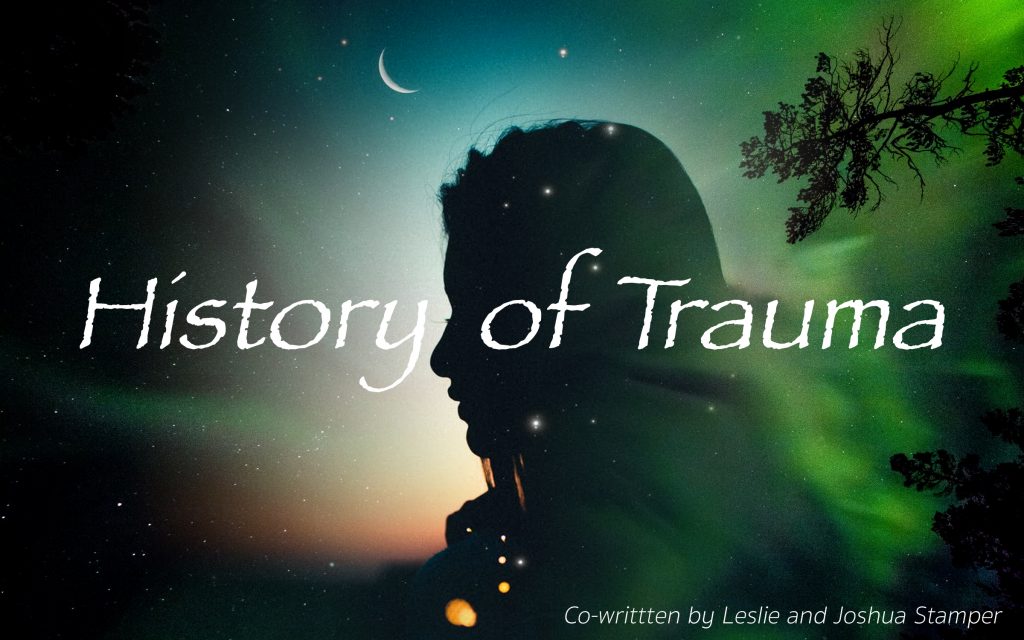History of Trauma

In this blog series, Leslie and Joshua Stamper have taken a deeper look at essential aspects of trauma informed practices, Trust Based Relationship Interventions, and Restorative Practices from the perspective of a parent and a school administrator. You can find our previous posts here: In the Face of Trauma and The Language of Behavior.
Josh and I (Leslie) are parents to five wonderful children. We were also foster parents for five years. One of the greater challenges in raising children with a history of trauma is understanding the motivation behind behaviors. Specifically, realizing that behaviors are the result of emotional dysregulation and not necessarily willful disobedience. Without a relationship built upon trust, which takes time and consistent connection, children who have a history of trauma may not have the tools and awareness to regulate themselves, which means the behaviors we see are not willful disobedience. The groundwork of TBRI (Trust-Based Relational Intervention) is to see the child, not the behavior. To view negative behavior as dysregulation rather than “bad choices” and meet that dysregulation with connection. This means not taking behaviors personally (he’s not following my rules, why can’t she sit still, he just won’t listen) and centering the child and his or her needs instead of the desired behavior or outcome in our minds.
Dysregulation in my children looks like dilated pupils, lack of eye contact, fidgeting or twitching, whining or crying, inability to form sentences, and can escalate to physically or verbally fighting back. When my kids are dysregulated, they are detached from their external environment and are unable to look me in the face or respond appropriately to my directions. In these moments of dysregulation, I have to keep in mind that they are not in control of themselves. Their amygdala has taken over and they are moving towards a fight/flight/freeze response. My goal in these moments is to bring them back to the present, to calm their nervous system and to help them regain control of themselves.
Each of my children are different in what tactics assist them when they are dysregulated, but each tactic is always based in understanding the underlying need and restoring an interpersonal with them. TBRI strategies that meet the child where they are and give back a sense of control have been most effective. Physically lowering myself down to their eye level (or lower), slow and calm words with short sentences or phrases, physical touch with a gentle hand on the shoulder or chin, a deep hug if they allow it, and guiding (not forcing) them to a quiet environment. This process can take a minute or an hour, depending on how dysregulated they are (whining and twitching versus fighting back), what their day has been like (before school they are able to regulate faster than after school), and how soon I recognized their need for regulation and stepped in to assist them. Once they appear more regulated (they will make eye contact with me and are able to form sentences), I ask them what they need. Most often, their response is water, food or a physical touch, which seems so simple, but goes back to the foundational levels of Maslow’s hierarchy of needs.
Understanding the situations and times where my kids become dysregulated helps me predict ways to support them. When I know their triggers, I can be prepared to help them maintain emotional regulation or understand and help them through times of dysregulation before they escalate. Transitions between home and school is a challenging time for one of my children. Crowded, chaotic and loud environments is challenging for another. Not fully understanding expectations is another trigger.
Our school has partnered with us in understanding triggers for dysregulation and meeting my kids’ needs. I see this in the way they make themselves available (both physically and emotionally) to help with morning transitions, their willingness to let my children lead in challenging moments by asking “what do you need.” The teachers allow my children to have access to water, take breaks from chaotic environments, and have a designated cool down space in the classroom that my child can choose to visit to regulate themself.
As a middle school administrator, I (Joshua) have seen a vast amount of escalating emotions resulting in negative behaviors. Unfortunately, more often than not, the triggers to the escalating emotional outbursts are the reactions to ineffective adult communication or actions. For example, a student is eating chips in the hallway, which is a violation of school rules. A teacher approaches the students and yells at the student to throw away the chips. The student responds, “Why? I’ll just put it in my locker!” The teacher grabs the chips out of the students hands, throws the chips in the garbage, and tells the student to go to class. As you can imagine, the situation has quickly escalated to an unhealthy level and, for a student who has experienced trauma, their adrenaline has increased and their brains have gone into survival mode. When interacting with any student you don’t know, assume the student has a history of trauma. If we don’t have a relationship with the student and we don’t know their personal story, we cannot assume that they possess the tools to regulate their emotions or work through adversity.
If a student is escalating emotionally and responds disrespectfully, instead of getting angry about the disrespect, our focus immediately needs to be on de-escalating the child to a normal emotional state. Often, the focus turns immediately to the disrespect and the student’s disobedient choice. In a situation when a person is at a heightened emotional state and the brain has gone into fight, flight, or freeze, any dialog will not be heard. To ensure de-escalation occurs:
Avoid Yelling and Blaming
When students have large emotions, resulting in big behaviors, we must model composure not mirror chaos. Yelling and using blaming language only heightens and escalates the situation, which will increase the negative behavior. In a recent interview with Todd Whitaker on Aspire to Lead (See Below), Todd stated, “never argue, never yell, and never use sarcasm…because it doesn’t result in de-escalation.” He followed by stating, “you don’t have to be mean. You just have to mean it.” It is best practice to use a calm voice, non-judgmental language to redirect, give personal space, provide choices and allow the student a quiet space to de-escalate.
Allowing Time in a Safe Space
It’s absolutely acceptable for students to be able to cool down in a safe and quiet space without consequences. Many teachers have a designated space in their classroom for students to cool down but a trusted adult needs to be with the student for de-escalation to occur. Allow time for the student to gain composure and don’t rush the process. Dialog doesn’t need to occur right away. A natural response is to immediately talk through the situation and the student’s choices, but we need to provide time for the adrenaline to subside. We are able to teach a student about their decisions once the are calm and have a regulated amygdala.
Debrief and Restore the Damage
Our goal should always be to teach our students how have effective communication, trusting relationships and the necessary tools to regulate their emotions. Once the student has had time to de-escalate, it’s imperative to review what occurred and how the student could change their actions, behavior or responses in the future. In addition, a plan of action needs to be established for the student to rectify the situation and the relationships affected.
We all began our journey as an educator to make a difference in students’ lives, and we have an amazing opportunity to counteract the hurt, mistrust, chaos, stress, malnourishment, anger, and shame caused by trauma or neglect. It’s not easy to be in a situation when a student is escalating, but as the adult, we must model stability and consistency to instill emotional regulation, trust, safety, and love. In times when our students are lacking the skills to cope, we can fill in the gaps to change the history of trauma.




